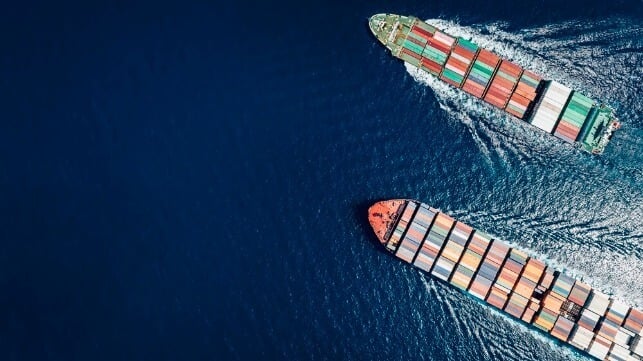Amidst Seafarer Shortage, Multi-orbit Connectivity is Key for Recruiting

Labor shortages remain rampant across many segments of the maritime industry.
In the shipping sector, merchant fleet owners and operators are struggling to find skilled workers as aging employees retire and younger prospects opt for onshore jobs that offer more lucrative compensation and are perceived to be safer. New regulations and rigorous training standards have made it even more difficult to quickly train new employees and fill open positions.
Similar labor challenges are hampering the commercial fishing industry, where companies are struggling to replace aging workers with a new generation of employees willing to take on the challenging and physical demands of the job. The industry’s notorious reputation for poor compensation, lackluster safety, and unappealing working conditions adds to the difficulty of competing against more appealing professions. Access to foreign workers due to changes in visa rules is presenting new complications as well.
All told, the International Chamber of Shipping (ICS) expects a shortfall of 90,000 maritime workers by next year, leading to significant shipping delays, supply chain disruptions, seafood shortages, and increased costs.
A Deeper Emphasis on Crew Welfare and Employee Satisfaction
To overcome labor shortages across the maritime sector, merchant shipping and commercial fishing fleet owners and operators need to directly appeal to the next generation of maritime talent while also retaining existing crews to prevent turnover. Doing so means providing greater education and skills training, improving compensation and working conditions, and offering opportunities for promotions and career advancement.
Closing the labor chasm also requires a renewed emphasis on crew welfare. This includes offering workers exceptional connectivity experiences at sea. Satellite communications, specifically multi-orbit connectivity, can play a crucial role in improving the quality of life and work for seafarers.

Courtesy Intelsat
Multi-orbit Satellite Connectivity is the Next Leap Forward
Maritime shipping and commercial fishing operators have long relied on satellite communications for connectivity at sea, historically for basic communications and distress and safety. As satellite technologies have evolved with faster speeds and more affordable bandwidth, maritime operators have expanded their use of satellite solutions to improve overall operations.
Maritime companies have new opportunities to access and leverage the best attributes of multiple satellite bands to not only dramatically enhance operational efficiencies but also elevate crew welfare standards, helping to combat attrition among existing workers and attract new ones.
Multi-orbit satellite solutions bring together the individual benefits and advantages of geostationary (GEO) and low-Earth orbit (LEO) connectivity. GEO satellites provide wide coverage and are ideal for basic connectivity needs. LEO satellites offer lower latency and higher throughput, which are essential for telemedicine and similarly demanding applications.
Elevating Happiness, Health, and Safety at Sea with Multi-orbit
By ensuring continuous, reliable connectivity regardless of a vessel's location, nature of the application in use, or bandwidth requirements, multi-orbit connectivity can allow any maritime fleet operator to introduce new connectivity features and capabilities that can have a profoundly positive impact on crew welfare.
Access to reliable connectivity ensures that merchant shipping and commercial fishing crews can stay connected with their families and loved ones throughout voyages of any duration, alleviating loneliness and improving morale during long periods away from home. Multi-orbit connectivity provides crews with a wide range of entertainment options and access to popular social media applications.
Multi-orbit satellite connectivity also plays a critical role in enhancing the mental and physical health of crews by powering telemedicine applications and response coordination in the event of a medical emergency. Crew members and their families can be assured that, should a medical emergency arise, they will have a reliable and robust link to remotely connect to and consult with a medical professional to receive advice and support in a timely fashion. This is of particular importance for fishing crews that operate in harsh physical and weather conditions where accidents and extreme physical fatigue are more common.
Finally, and in addition to those connectivity features that are specifically intended for workers at sea, multi-orbit connectivity also enhances operational efficiencies by enabling real-time data exchange and the ability to conduct remote diagnostics that can pre-empt mechanical issues and reduce downtime. Additionally, with access to real-time, highly detailed weather data, crews can more effectively optimize routes and use of fuel, all of which results in safer, potentially shorter, more successful voyages and more satisfied employees.
Intelsat Brings Transformative Multi-orbit Solutions to the Maritime Industry
Intelsat is a longtime leader in providing satellite connectivity solutions to merchant shipping and enterprise fishing operators. With FlexMaritime Duo, Intelsat now offers the flexibility of a multi-orbit (GEO + LEO), or LEO-only managed service structured to meet unique connectivity and business requirements.
By adding LEO coverage in dangerous fishing areas and busy shipping routes to the global, ultra-reliable, high-throughput coverage of the FlexMaritime GEO network, merchant ships and fishing crews gain the added benefit of a LEO service supporting data-intensive applications and are assured of always-available, robust, global connectivity anywhere they sail.
With no signs of improvement on the horizon in labor supply within the maritime industry, adopting a multi-orbit satellite connectivity strategy can give maritime fleet owners and operators an upper hand in recruiting efforts while, at the same time, keeping turnover rates at bay.
This article appears courtesy of Intelsat.
The opinions expressed herein are the author's and not necessarily those of The Maritime Executive.
